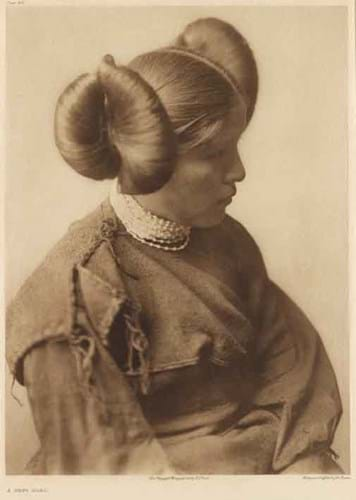
It has also been called "an absolutely unmatched masterpiece of visual anthropology, and one of the most thorough, extensive and profound photographic works of all time".
Curtis aimed to document every Indian tribe west of the Mississippi, but it took decades to complete - not the five years he had first envisaged - and exceeded its budget by $1.4m, an enormous sum in the early decades of the last century.
Having made his first portrait in 1895, Curtis went on to produce 40,000 negatives featuring Indians from 80 tribes before the project was finally completed in 1930 - but production of the great work had begun in 1907.
He had planned an edition of 500 sets, and in this he had a valuable supporter in President Teddy Roosevelt, whose testimonial is quoted here:
"I regard the work you have done as one of the most valuable works which any American could now do. Your photographs stand by themselves, both in their wonderful artistic merit and in their value as historical documents. You are now making a record of the lives of the Indians of our country which it would be the greatest misfortune, from the standpoint alike of the ethnologist and the historian, to leave unmade..."
Patronage and Bankruptcy
It was Roosevelt who introduced Curtis to J. Pierpont Morgan, the man who provided the patronage and continuing financial support he needed, but in the end only an estimated 272 sets were completed before Curtis was bankrupted and the plates became the property of the printers and publishers he had employed.
Many sets were subsequently broken up but it is reckoned that around 85 survive in institutional collections. This year, however, we have already seen two at auction.
Three different issues of The North American Indian were produced - 40 sets on Japanese tissue and the remainder roughly divided between those on Van Gelder paper and the more desirable Japanese vellum.
New York Auction
In 2007, Swann Auction Galleries sold an incomplete set for $900,000, which was at the time the highest bid ever taken in their New York salerooms, but on October 4 of this year, as part of one of their regular photograph and photo-book sales, they recorded the first million-dollar bid in the saleroom's 70-year history when set No.113 reached $1.2m (£744,120).
Entered for sale by a long-established Detroit bookseller, John King, it was a complete example, the 20 portfolios containing 722 large format photogravures on Japanese tissue, of which 111 are signed by Curtis, while the 20 text volumes on Japanese vellum present a further 1505 small-format photogravures, some hand coloured.
Swanns may be a little disappointed in the result, having hoped for a price in the region of $1.25m-1.75m. In 2005, Christie's sold the ex-Parker Corning/University of Texas set on Van Gelder paper for $1.25m while in April of this year all previous Curtis records were indeed broken.
Billed at the time as "perhaps the finest obtainable set", the highly desirable vellum copy in Kenneth Nebenzahl's library, an exceptionally well-preserved set, the bindings fresh and bright and the plates showing none of the offsetting and tissue burn found in many sets, made $2.5m (£1.91m) at Christie's New York.




